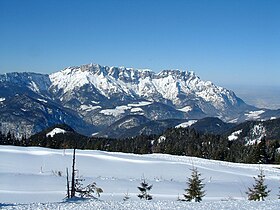The Untersberg is a massif of the Berchtesgaden Alps, a prominent northern spur that straddles the border between Berchtesgaden, Germany and Salzburg, Austria. The highest peak of the table-top mountain is the Berchtesgaden Hochthron at 1,973 metres (6,473Â ft).
§Geography

The Untersberg rises at the rim of the Northern Limestone Alps, immediately at the Salzburg Basin and the broad Salzach Valley. Neighbouring peaks are the Hoher Göll in the southeast and Mt. Watzmann in the south, beyond the Berchtesgaden Basin. In the northwest, the Saalach Valley with Bad Reichenhall separates it from the Hochstaufen mountain range. About two-thirds of the area, including the Berchtesgaden Hochthron, is located in Germany, while the northernmost steep edge above Salzburg belongs to Austria.
The mountain is popular with tourists due to its proximity to the city of Salzburg: less than 16 kilometres (9.9 mi) south of the city centre and within easy reach by bus, for example city bus line 25 to Grödig, which runs every 15 minutes on weekdays. Several trails lead to the top, though most people prefer the Untersbergbahn cable car. Constructed over a period of over two years, and opening in April 1961, the eight and a half minute journey lifts passengers from the lower terminus at the village of St. Leonhard at 456 m (1,496 ft) over 1,320 m (4,330 ft) to the Geiereck spur at an altitude of 1,776 m (5,827 ft), transporting them a horizontal distance of almost 2.5 km (1.6 mi).
The first recorded ascent was in the first half of the 12th century, by Eberwein, a member of the Augustinian monastery at Berchtesgaden. The mountain lends its name to an 1829 opera, Der Untersberg, by Johann Nepomuk von Poißl (1783â€"1865), and has inspired a series of works by German artist Stephan Hess.
§Peaks
- Berchtesgaden Hochthron: 1973 m
- Rauheck: 1892 m
- Gamsalpkopf: 1888 m
- Salzburg Hochthron: 1853 m
- Mitterberg: 1840 m
- Geiereck: 1805 m
§Geology

The Untersberg massif is mainly made up of limestone, a bed of Dachstein chalkâ€"mined as "Untersberg marble"â€"on a dolostone basis, and of small deposits of bauxite.
The Karst topography of the limestone includes numerous caves. So far, more than 400 have been exploredâ€"including the Schellenberg ice cave at an elevation of 1,570 m (5,150 ft), a show cave since 1925, and the Kolowrat Cave with a 300 m (980 ft) high dome. The Riesending cave with a depth of 1,059 m (3,474 ft) and a length of 18.2 km (11.3 mi) is the largest known in Germany. There also is a lake at 930 m (3,050 ft) depth. An expedition in August 2008 revealed that its lowest point had not yet been reached.
§Marble ball mills
The Untersberger marble ball mills are located in Marktschellenberg in Berchtesgaden, at the opening of the Almbachklamm valley.
The Kügelmühlen (ball mills) were established in 1683. Once popular children's toys, these marbles were shipped all over the world. Through Rotterdam and London, marble shipping was directed toward the East and West Indies and exported at the rate of 60,000 to 80,000 (and sometimes as high as 100,000) pounds per year. Marbles were welcome as cargo in sailing ships, as they were suitable as ballast because of their high density. The last marbles went from Untersberg to London in 1921.
As late as the 1850s, the Almbach valley had 40 ball mills with another 90 in the surrounding region, worked mainly by poor mountain farmers. Today, a single ball mill operates primarily as a tourist attraction.
The ball mills were driven by the waters of the Almbach river. The lower fixed grinding stones are made of hard sandstone and the upper turntables from beech wood. Grinding of the balls varies from two to eight days according to their size. After course grinding on the sandstone, the marble balls underwent sanding and a polish.
Untersberg marble also forms the facade of buildings such as the Salzburg Cathedral.
§Legend
According to a king in the mountain legend, Emperor Frederick Barbarossa is asleep inside Mt. Untersberg until his resurrection. His beard is said to be growing longer and longer around a round table and to have grown round two times. Myth says that when the beard has grown three times around the table the end of the world has come. When Frederick leaves the mountain, there will be no further Holy Roman Emperor and the last great battle of humankind will be fought on the Walserfeld, a pasture at Wals, west of Salzburg. There is a similar legend for the Kyffhäuser Mountain in Thuringia.
Other legends say that it is Charlemagne waiting inside the Untersberg, taken care of by the Untersberger Mandln, small dwarf-like creatures. Every hundred years he awakes and when he sees the ravens still flying around the Untersberg he sleeps for another century. The Alpine tradition of the Untersberg Wild Hunt has recently been revived. There are also legends about the cave system below the mountain.
§Gallery
§See also
- Salzburgerland
- Bavaria
§References
§External links
- Outlook from Untersberg
- Salzburg Tourist Office â€" salzburg city tourist board website.
- Information on marble ball mills

Posting Komentar